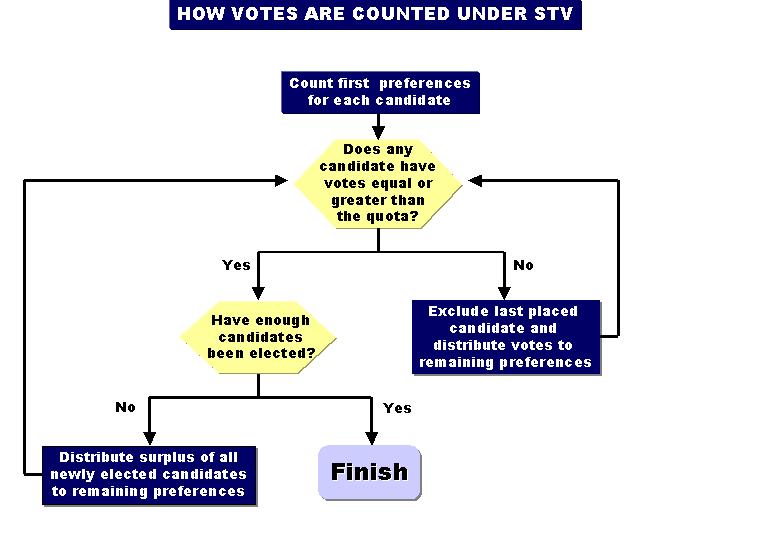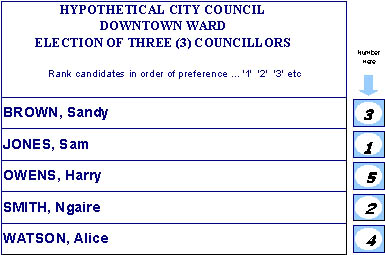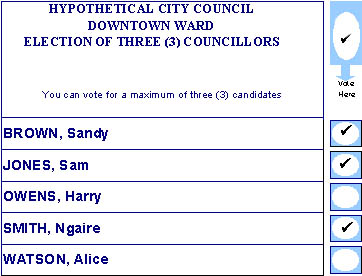All about STV and FPP
About STV
Under a STV (Single-Transferable Vote) electoral system, voters rank candidates in their order of preference. A good example to consider is an election to select three councillors for a ward in a council election. Under STV, you would write “1” next to the name of your favourite candidate, “2” next to your second favourite candidate and so on.
STV means that you have one vote, but can indicate your preferences for all the candidates and it can be transferred if your most preferred candidate is so popular s/he doesn't need all their votes or is not popular at all with other voters. Under FPP, you would place ticks next to the names of up to three candidates, which means you would have three votes.
The number of vacancies and votes determines the quota a candidate must reach to be elected. The formula for deciding the quota is total number of valid votes, divided by the the number of vacancies plus one. This process is illustrated in the diagram below.

An animated demonstration of this process is on the www.stv.govt.nz site.
STV Voting Form
This is how a voting form might look for a local authority election held under the Single Transferable Vote method.

There are three vacancies in this ward. Instead of a tick you rank candidates in the order you prefer – “1” beside your first choice, "2” beside your second choice, “3” beside your third choice and so on. You can rank as few or as many candidates as you wish.
Here's How STV Works
Candidates must reach a set number (quota) of votes in order to be elected. By numbering your preferences you are saying:
"The candidate I most want to represent me on the council is Sam Jones. He's my number one choice - but if he gets more votes than the quota, then part of my vote is to be transferred to my second choice, Ngaire Smith, and maybe this will help to get her elected. On the other hand, if Sam has so little support that he can't possibly be elected, transfer my vote to Ngaire..."
About FPP
Under the FPP (First Past the Post) electoral system, the candidate with the most votes wins. This is a very simple method of electing candidates and is widely used throughout the world. It was used in New Zealand for Parliamentary elections up until the introduction of MMP (Mixed Member Proportional) in the 1996 general election. Although FPP is very simple, some people have argued that the results of an FPP election may not always reflect the wishes of the majority of voters. The following examples show how results of FPP elections may vary. Where one candidate has a clear majority of votes, it can be seen that the majority of people did support the winning candidate –
| Number of Votes | Percentage of Votes | |
|---|---|---|
| Candidate One | 140 | 70% |
| Candidate Two | 20 | 10% |
| Candidate Three | 20 | 10% |
| Candidate Four | 20 | 10% |
| Total Votes = 200 | Total Votes = 100% |
In this example, the winning candidate received 70 percent of the total votes. However, the winning candidate might receive more votes than any other one candidate, but receive fewer votes than the other candidates put together.
| Number of Votes | Percentage of Votes | |
|---|---|---|
| Candidate One | 80 | 40% |
| Candidate Two | 60 | 30% |
| Candidate Three | 40 | 20% |
| Candidate Four | 20 | 10% |
| Total Votes = 200 | Total Votes = 100% |
In this case, the winning candidate got 40 percent of the total votes, the other candidates received 60 percent of votes. It could be said that the election result did not reflect the wishes of the majority. Some people have also argued that even where the winning candidate gets the majority of the votes, many people’s votes are “wasted”.
FPP Voting Form
This is a typical voting form for a local authority election held under the First Past the Post method.

In this case, there are three vacancies in the ward and voters can tick up to three candidates.